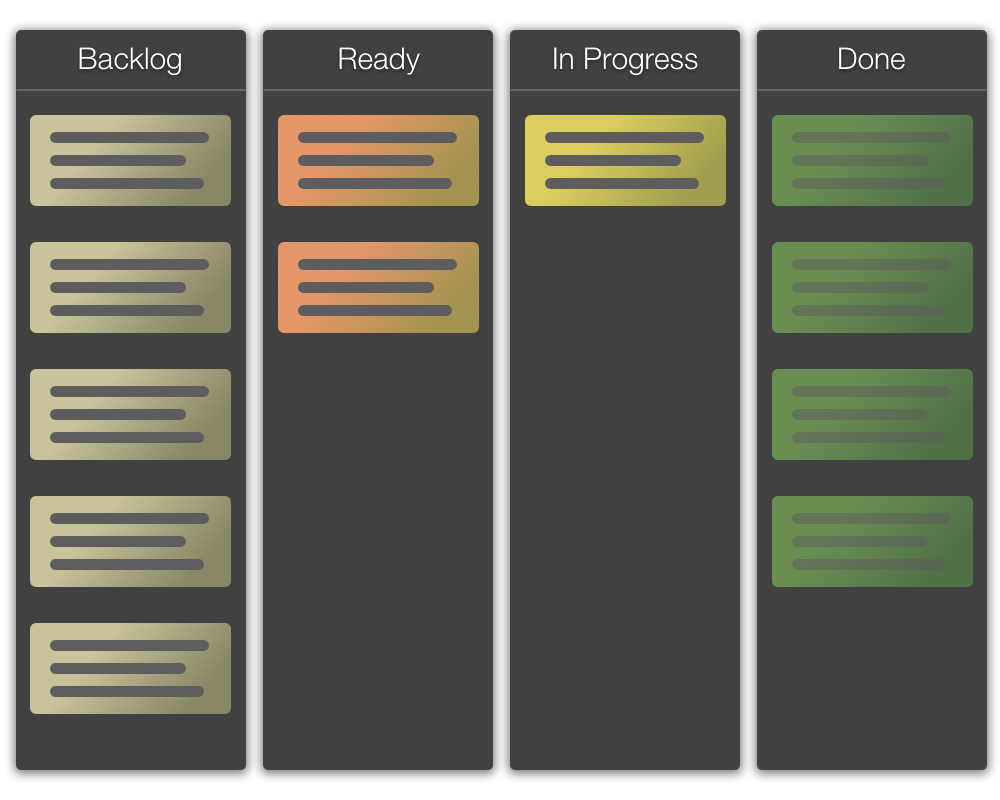Tools of the fad, part II: kanban

What’s what
Kanban is a workload management method, a work “flow” that is supposed to organically induce a well-balanced collaboration and performant execution through its transparent processes.
The central point of the kanban method is its board, which is divided into vertical sections representing the lifecycle of a task. These sections can have different names, such as:
Backlog → Ready → In Progress → Done
If a team wanted to include other processes like testing, design reviews, quality checks, etc., they can add more (or fewer) sections.
Variations of the board may include swim lanes, horizontally dividing the board by grouping tasks according to arbitrary characteristics.
As widespread as Kanban is on the internet, there are many descriptions of it, confirming how subjectively people can absorb the same information. Or maybe that the original information has evolved and diverged in so many directions, that no one even remembers what it should actually be? Who knows :-)
One thing is certain, however: Kanban is popular, and becoming increasingly popular, against the principles that made it and even without the actual need for it.
Every single GTD and to-do app must now have a kanban board to present a team’s view for 1-person task management.
A devil in disguise
Wikipedia pinpoints the origin of kanban to a timeframe between 2004 and 2007, but there are rumours that it may be older than that.

For many people, Kanban did not materialise before the app called Trello emerged. Initially, it was a revelation:
Wow, my simple not-really-flat task list can now be represented by boxes inside other boxes! And I can rearrange all these boxes by dragging them on top of each other!
So cool, right? Not exactly.
- Firstly, my task-list has not been flat, but nested. Tasks had sub-tasks and sub-tasks had sub-sub-tasks and so on. Sure, Trello, and all the other kanban apps allow me to add sub-tasks to tasks, but they are now buried under a click.
- Secondly, when I complete my tasks, they (usually) remain on the board. I have to “archive” them or something.
These “problems” are typically handled by the apps, and are not that severe, but a person must give in and be completely assimilated by the Team so that any remnants of individuality are eradicated. Only then, they can become part of the board and be happily dragged and dropped across the board, with the rest of the “resources”.
Ultimately, kanban is a process that conflicts with the simple methodology of Getting Things Done (GTD), where an individual focuses on only the tasks that matter, one at a time. Where constantly looking at the big picture is a distraction, rather than a necessity. Where completed tasks disappear from the list, and are not just dragged a little to the right.
Maybe GTD could supplement the team’s kanban board? If someone duplicated all their tasks in another app, or on paper, that is, if one has the choice, and wants to use the right tool for the job, and, most importantly, has the time to do so.
A computerised version of the kanban board (as opposed to a whiteboard with a sloppily markered table and stickies full of undecipherable scribbles, that fall off quicker than your burn-down chart) provides a cleaner view, and additional features. We can get comments, attachments, links, and stats for the managers. And most importantly – filters. Without filters and tags, kanban would not scale. Teams with thousands of tasks would not be able to prioritise or even find anything (and with such high numbers of tasks/issues, they probably have more important problems than going through these tasks, anyway).
Kanban and ADD
The key to a successful day for anyone struggling to focus on boring, everyday tasks is clarity. That means removing anything that is not essential to that one single task.
In the case of a task manager, that means a list of tasks that is carefully planned each morning and executed throughout the day. Anything superfluous and the focus will be lost. That’s why Pomodoro and GTD work so well for hyperactive minds. Kanban, on the other hand, is a complete opposite. It shows you the all-in-one big picture. A big picture, which a well-organised person may need to see when planning a month, a week or maybe even a day. But not all the time.
And when tasks are completed, a GTD app would just remove them from the list. On kanban board – you just drag them to the right.
Where does it belong?
So, why is kanban so popular, you might ask.
For one, it jumped onto the Agile Development train and is still dragging along (hopefully, not for much longer).
For two, somehow it became synonymous with serious work. Where one would see how much their big team in a big corporation has done in, e.g., 2 weeks, and just wanted to take the same productivity home, not realising that the velocity came from numbers not processes. And the processes and strange rituals actually slowed everything down.
Another reason may be that the Trello clones have started popping up everywhere, becoming overhypedly available to anyone with the internet.
Because, the most important thing about kanban, that is not that evident from all the ads, is that it does NOT make sense for 1 person!
It makes sense for a team, with planners and executors, managers and developers, people or even whole teams responsible for different sections, where one team would generate tasks, another would prioritise and yet another would execute them, and so on.
It is just one tool in a bigger set of the full methodology, and when it’s ripped out of it and stuffed into one’s smartphone to manage a shopping list – it is an overhead and a shot in the foot.
A nice diagram from LucidChart best explains where kanban excels. The path to kanban suggests that:
- The most critical thing (for a team) should be flexibility. Not a clearly defined plan, not a specific objective, nor even the elimination of waste (waste of time, I suspect, rather than… the other one).
- The end goal of the team cannot be clear. If it is – it’s not a good idea to use kanban.
- The next characteristic is that customers don’t need to decide what gets done. If they wanted to decide – it’s extreme programming, not kanban.
- Lastly, we don’t want to plan nor review our tasks every 2 weeks or so.
If all these are fulfilled, kanban is the best tool and best methodology for our team. Otherwise, there are better choices. And with that in mind, it’s difficult to imagine someone’s personal TODO list with these assumptions. A list like that may resemble a new year’s resolution list, which once written is tossed to the bottom of a drawer and forgotten, rather than reviewed every day and actually resolved.
But what do I know. I’m not everyone.
Ultimately, the key to successful productivity is finding the tools and methods that work best for you or your team, and adapting them to fit your unique circumstances.
Further reading
If you would like to learn more about kanban and its implementation, here are some resources you can check out:
- "Kanban: Successful Evolutionary Change for Your Technology Business" by David J. Anderson, a comprehensive guide to implementing kanban in a business setting
- "Personal Kanban: Mapping Work | Navigating Life" by Jim Benson and Tonianne DeMaria Barry, a guide to using kanban for personal productivity
- "The Basics of Kanban Methodology" by Kanbanize, an overview of the kanban method and its principles
- "Kanban vs. Scrum: Choosing the Right Agile Project Management Methodology" by Wrike, a comparison of the two popular agile methodologies
Member discussion